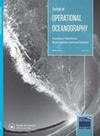A study on causes and recurrence of the Mid-Mediterranean Jet from 2003 to 2015 using satellite thermal and altimetry data and CTD casts
IF 2.4
3区 地球科学
Q4 METEOROLOGY & ATMOSPHERIC SCIENCES
引用次数: 2
Abstract
ABSTRACT The existence of the Mid-Mediterranean Jet (MMJ) as part of the pathway of the Atlantic Water (AW) in Eastern Mediterranean is still debated and the reasons for its formation are unknown. The MMJ was investigated over the 2000–2015 summers using thermal and altimetry satellite data and ‘in situ’ casts. In the Levantine basin, the AW flowing along the Libyan-Egyptian coast splits into an along-shore and an offshore branch, the latter following the northern border of the warm anti-cyclones located near the African coast (Libyan-Egyptian Eddies, LEEs). The MMJ is triggered when a surface cold water mass formed south-east of Crete, in part outflowing the Aegean Sea and in part generated within the Rhodes Gyre, moves southward and intrudes the middle Levantine basin. The surface cold water overlays the AW flowing along the northern periphery of LEEs that sinks dozens of metres below increasing its budget of anti-cyclonic vorticity and causing the formation of the jet. Satellite data show that the MMJ formed every summer from 2003 to 2015, sometimes for limited periods of time and at different latitudes, with the exception of summers 2005–2006, probably due to the weakness of the African anti-cyclones that in those years did not advect AW offshore.基于卫星热高程数据和CTD模型的2003 - 2015年地中海中部急流成因及重现分析
中地中海急流(MMJ)作为东地中海大西洋水(AW)路径的一部分,其存在仍有争议,其形成的原因尚不清楚。在2000年至2015年的夏季,利用热测和测高卫星数据和“原位”cast对MMJ进行了调查。在黎凡特盆地,沿利比亚-埃及海岸流动的阿西风分为沿岸分支和近海分支,后者跟随位于非洲海岸附近的温暖反气旋的北部边界(利比亚-埃及涡流,LEEs)。MMJ是由克里特岛东南部形成的表面冷水团触发的,其中一部分流出爱琴海,一部分产生于罗德环流,向南移动并侵入中部黎凡特盆地。表面的冷水覆盖在沿LEEs北部边缘流动的AW上,下沉数十米,增加了反气旋涡度的预算,并导致了急流的形成。卫星数据显示,除了2005-2006年夏季外,MMJ在2003 - 2015年的每个夏季都会形成,有时会在有限的时间和不同的纬度形成,这可能是由于非洲反气旋的弱点,在那些年没有向海上平流。
本文章由计算机程序翻译,如有差异,请以英文原文为准。
求助全文
约1分钟内获得全文
求助全文
来源期刊
CiteScore
7.50
自引率
9.70%
发文量
8
审稿时长
>12 weeks
期刊介绍:
The Journal of Operational Oceanography will publish papers which examine the role of oceanography in contributing to the fields of: Numerical Weather Prediction; Development of Climatologies; Implications of Ocean Change; Ocean and Climate Forecasting; Ocean Observing Technologies; Eutrophication; Climate Assessment; Shoreline Change; Marine and Sea State Prediction; Model Development and Validation; Coastal Flooding; Reducing Public Health Risks; Short-Range Ocean Forecasting; Forces on Structures; Ocean Policy; Protecting and Restoring Ecosystem health; Controlling and Mitigating Natural Hazards; Safe and Efficient Marine Operations

 求助内容:
求助内容: 应助结果提醒方式:
应助结果提醒方式:


